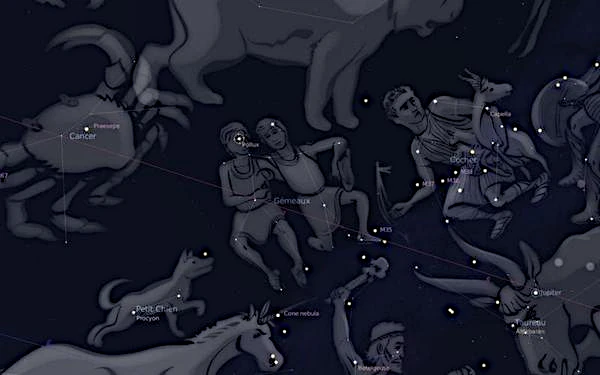
Image: Constellation of Gemini. Image reworked from the Open Source software Stellarium.
We are going to explore a fascinating constellation: the constellation of Gemini. This constellation is located in the northern hemisphere and is visible during the winter months. It is easy to spot because it contains two bright stars that seem close to each other, forming a pair of twins.
In Greek mythology, the constellation of Gemini is associated with Castor and Pollux, two famous twin brothers. Castor was a skilled horseman, while Pollux was an expert in the art of boxing. The constellation of Gemini is also known for being the first constellation drawn by ancient astronomers.
The constellation of Gemini contains two main stars called Castor and Pollux. Castor is a white and yellow star, while Pollux is a reddish star. Although they appear close to each other, Castor and Pollux are actually very far apart, separated by millions of kilometers.
In addition to Castor and Pollux, the constellation of Gemini also contains many other interesting stars. One of these stars is Alhena, which means "the mark" in Arabic. Alhena is a blue and white star located about 105 light-years from Earth.
The constellation of Auriga is located in the Milky Way, the white band of stars that can be seen in the night sky. It is part of a group of constellations called the winter constellations, which also include Orion, Taurus, and Auriga.
The constellation of Gemini also contains a nebula called the Eskimo Nebula. This nebula looks like the head of an Eskimo wearing a hood, hence its name. The Eskimo Nebula is a fascinating object to observe through a telescope, as it has a unique shape and is filled with colorful gases.
By exploring the constellation of Gemini, you can learn more about the universe and discover all the wonders it has to offer. So, next time you look at the night sky, try to spot the constellation of Gemini and all the bright stars it contains.